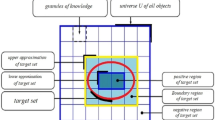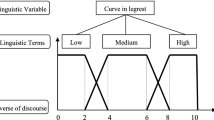Abstract
In order to improve the ability of quantitative evaluation of e-commerce advertising click rate, a model of e-commerce advertising click rate evaluation based on fuzzy genetic algorithm is proposed. The big data information sampling model of e-commerce advertisement click rate evaluation, based on the mining result of e-commerce advertisement click rate evaluation information, carries on the adaptive mining and fusion clustering processing to the e-commerce advertisement click rate evaluation data, extracts the similarity information of the e-commerce advertisement click rate distribution set, carries on the e-commerce advertisement click rate adaptive evaluation according to the similarity contrast method, carries on the feature coding in the e-commerce advertisement click rate evaluation process through the fuzzy genetic optimization method, establishes the e-commerce advertisement click rate reliability feature distribution function, combines the statistical feature analysis and the fuzzy feature cluster analysis method to evaluate and predict the e-commerce advertisement click rate. The simulation results show that this method has better adaptability, higher accuracy and better convergence.







Similar content being viewed by others
References
Li LM, Cheng SK, Wen ZZ, Xiao MW, Xu GQ, Zhang SF (2019) A debris flow prediction model based on the improved kpca and mixed kernel function LSSVR. Inform Control 48(5):536–544
Caggiano A (2018) Tool wear prediction in Ti-6Al-4V machining through multiple sensor monitoring and PCA features pattern recognition. Sens 18(3):823
Jea KF, Wang JY, Hsu CW (2019) Two-agent advertisement scheduling on physical books to maximize the total profit. Asia Pac J Oper Res 36(3):14–16
Hwang JS, Doh SJ (2017) Advances in research methodology in digital media advertising research. Adver Res 115:143–191
Yang Q, Xie Q, Jiang Y (2019) Joint effects of visual saliency, task type and content consistency on attention effect of online advertising. Ind Eng Manage 024(003):180–187
Wu CZ, Wang XY, Chen MC, Kim MJ (2019) Differential received signal strength based RFID positioning for construction equipment tracking. Adv Eng Inform 42:100960
Zeng HB, Liu XG, Wang W (2019) Xiao SP (2019) New results on stability analysis of systems with time-varying delays using a generalized free-matrix-based inequality. J Franklin Inst 356(13):7312–7321
Zhu JX, Wu P, Chen MC, Kim MJ, Wang XY, Fang TC (2020) Automatically processing IFC clipping representation for BIM and GIS integration at the process level. Appl Sci 10(6):2009
Hou YX, Yang GC, Fan XM (2018) Research on vehicle network advertising delivery based on friends relationship. Open J Transp Technol 7(05):359–369
Guerra V, Llusia D, Gambale PG, Morais AR, Márquez R, Bastos RP (2018) The advertisement calls of Brazilian anurans: Historical review, current knowledge and future directions. PLoS ONE 13(1):191–201
Zeng H, Liu X, Wang W (2019) A generalized free-matrix-based integral inequality for stability analysis of time-varying delay systems. Appl Math Comput 354:1–8
Zhang HR, Qu SC, Li H, Luo J (2020) A moving shadow elimination method based on fusion of multi-feature. IEEE Access 8:63971–63982
Goyal S, Garg P, Mishra VN (2019) New composition of graphs and their Wiener Indices. Appl Math Nonlinear Sci 4(1):163–168
Naeem M, Siddiqui MK, Guirao JLG, Gao W (2018) New and modified eccentric indices of octagonal grid Omn. Appl Math Nonlinear Sci 3(1):209–228
Mi C, Cao L, Zhang Z, Feng YF, Yao L, Wu YB (2020) A port container code recognition algorithm under natural conditions. J Coast Res 103(sp1):822
Ni T, Liu D, Xu Q, Huang Z, Liang H, Yan A (2020) Architecture of cobweb-based redundant TSV for clustered faults. IEEE T Vlsi Syst 28(7):1736–1739
Zhou H, Wu P, Wang XL (2020) Evaluation and strategy research on online advertising delivery mode of duopoly enterprises based on price discrimination. Contr decis 35(08):164–176
Mei W (2020) The research on Internet advertising in the network marketing strategy of small and medium-sized enterprises. Comput knowl technol 16(06):47–48
Zhao X (2020) Research on influencing factors of personalized advertising avoidance in social media: taking privacy concerns as moderating variables. Front Soc Sci 9(10):7
Acknowledgements
The study was supported by “General Research Projects of Philosophy and Social Sciences in Colleges and Universities in Jiangsu Province, China (Grant No. 2021SJA1140)” and “Special Project for Doctoral Research of Xuzhou College of Industrial Technology, China (Grant No. XGY2021EA01)”.
Author information
Authors and Affiliations
Corresponding author
Additional information
Publisher's Note
Springer Nature remains neutral with regard to jurisdictional claims in published maps and institutional affiliations.
Rights and permissions
About this article
Cite this article
Song, P., Chen, C. & Zhang, L. Evaluation Model of Click Rate of Electronic Commerce Advertising Based on Fuzzy Genetic Algorithm. Mobile Netw Appl 27, 936–945 (2022). https://doi.org/10.1007/s11036-022-01916-8
Accepted:
Published:
Issue Date:
DOI: https://doi.org/10.1007/s11036-022-01916-8




